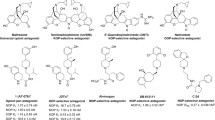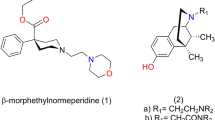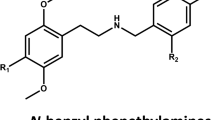Abstract
Highly selective heterocyclic opioid ligands with potent δ-antagonist activity have been developed on the basis of the “message-address” concept. Using this strategy, benzofuran derivatives corresponding to the non-selective opioid antagonist, naloxone, and to the μ-opioid receptor selective agonists, oxymorphone and oxycodone, were synthesized. In vitro opioid receptor binding profiles and agonist/antagonist character of these compounds were determined in rat brain membrane preparations with highly selective radioligands. All three benzofuran derivatives displayed high affinities for the δ-opioid receptor, much less potency toward the μ-binding site, and were the least effective at the κ-site. The results indicated that the addition of the bezofuran moiety to these fused ring opioids confers δ-receptor selectivity. The Na+ indices suggested a partial agonist character for oxymorphone- and oxycodone-benzofuran, and an antagonist character for naloxone-benzofuran. These compounds were capable of irreversible inhibition of opioid binding sites in a dosedependent.
Similar content being viewed by others
REFERENCES
Borsodi, A., and Tóth, G. 1995. Characterization of opioid receptor types and subtypes with new ligands. Ann. NY Acad. Sci. 757:339-352.
Schiller, P. W. 1991. Development of receptor-specific opioid peptide analogues. Pages 301-340, in Ellis, G. P., and West, G. B. (eds.), Progress in Medicinal Chemistry, Vol. 28, Elsevier Science Publishers, Amsterdam.
Takemori, A. E., and Portoghese, P. S. 1992. Selective naltrexone-derived opioid receptor antagonists. Annu. Rev. Pharmacol. Toxicol. 32:239-269.
Gold, M. S., Dackis, C. A., Pottash, A. L., Sternbach, H. H., and Anitto, W. J. 1982. Naltrexone, opiate addiction and endorphins. Med. Res. Rev. 2:211-246.
Zimmerman, D. M., and Leander, J. D. 1990. Selective opioid receptor agonists and antagonists: research tools and potential therapeutic agents. J. Med. Chem 33:895-902.
Schwyzer, R. 1977. ACTH: a short introductory review. Ann. NY Acad. Sci. 247:3-36.
Portoghese, P. S. 1989. Bivalent ligands and the message-address concept in the design of selective opioid receptor antagonists. Trends Pharmacol. Sci. 10:230-235.
Portoghese, P. S., Sultana, M., Nagase, N., and Takemori, A. E. 1988. Application of the message-address concept in the design of highly potent and selective non-peptide δ opioid receptor antagonist. J. Med. Chem. 31:281-282.
Portoghese, P. S., Sultana, M., and Takemori, A. E. 1990. Design of peptidomimetic δ opioid receptor antagonists using the message-address concept. J. Med. Chem. 33:1714-1720.
Portoghese, P. S., Nagase, H., MaloneyHuss, K. E., Lin, A.-E., and Takemori, A. E. 1991. Role of spacer and address components in peptidomimetic δ opioid receptor antagonists related to naltrindole. J. Med. Chem. 34:1715-1720.
Krizsan, D., Varga, E., Hosztafi, S., Benyhe, S., Szücs, M., and Borsodi, A. 1991. Irreversible blockade of the high and low affinity [3H]naloxone binding sites by C-6 derivatives of morphinane-6-ones. Life Sci. 48:439-451.
Fürst, S., Fiederman, T., Hosztafi, S., and Borsodi, A. 1994. Different μ opioid receptor subtypes may mediate C-6 substitutes oxycodone derivatives induced antinociceptive, gastrointestinal and respiratory actions. Regul. Pept. Suppl 1:S105-S106.
Tóth, G., Krámer, T. H., Sirokman, F., Borsodi, A., and Ronái, A. Z. 1982. Preparation of [7,8,19,20-3H]naloxone of high specific activity. J. Label. Com. Radiopharm. 19:1021-1030.
Yamamura, M. S., Horvath, R., Tóth, G., Ötvös, F., Malatynska, E., Knapp, R. J., Porreca, F., Hruby, V. J., and Yamamura, H. I. 1992. Characterization of [3H]naltrindole binding to delta opioid receptors in rat brain. Life Sci. 50:PL119-PL124.
Borsodi, A., Ozdemirler, G., Nevin, S. T., Kabasakal, L., Ötvös, F., and Tóth, G. 1993. Binding characteristics of the delta antagonist [1,5′-3H]naltrindole in rat brain membranes. Br. J. Pharmacol. 109:17.
Nevin, S. T., Kabasakal, L., Ötvös, F., Tóth, G., and Borosodi A. 1994. Binding characteristics of the novel highly specific delta agonist [3H]Ile5,6deltorphin II. Neuropeptides 26:261-265.
Nevin, S. T., Tóth, G., Weltrowska, G., Schiller, P. W., and Borsodi, A. 1995. Synthesis and binding characteristics of tritiated TIPP[ω], a highly specific and stable delta opioid antagonist. Life Sci. 56:PL225-PL230.
Simon, J., Benyhe, S., Abutidze, K., Borsodi, A., Szücs, M., and Wollemann, M. 1986. Kinetics and physical parameters of rat brain opioid receptors solubilized by digitonin and CHAPS. J. Neurochem. 46:695-701.
Vaughn, L. K., Knall, R. J., Tóth, G., Wan, Y.-P., Hruby, V. J., and Yamamura, H. I. 1989. A high affinity, highly selective ligand for the delta opioid receptor: [3H]-[D-Pen2,pCl-Phe4,D-Pen5]enkephalin. Life Sci. 45:1001-1008.
Bradford, M. M. 1986. A rapid and sensitive method for the quantitation of microgram quantities of protein utilizing the principle of dye-binding. Anal. Biochem. 72:248-254.
Munson, P. J., and Rodbard, D. 1980. LIGAND: a versatile computerized approach for characterization of ligand binding studies. Anal. Biochem. 107:220-227.
Ötkem, H. A., Varga, E., Hepp, J., Medzihradzky, K., Lajtha, A., and Borsodi, A. 1991. Opioid receptor labelling with the chlormethyl ketone derivative of [3H]-Tyr-D-Ala-Gly-(Me)Phe-Gly-ol (DAMGO) I: Binding properties of [3H]-Tyr-D-Ala-Gly-(Me)Phechlormethyl ketone. Life Sci. 48:1757-1762.
Handa, B. K., Lane, A. C., Lord, J. A. H., Morgan, B. A., Rance, M. J., Smith, C. F. C. 1981. Analogues of β-LPH61–64 possessing selective agonist activity at μ-opiate receptors. Eur. J. Pharmacol. 70:531-540.
Lahti, R. A., Mickelson, M. M., McCall, J. M., and Von Voightlander, P. F. 1985. [3HU69-593, a highly selective ligand for the opioid κ receptor. Eur. J. Pharmacol. 109:281-284.
Pert, C. B., and Snyder, S. H. 1973. Properties of opiate-receptor binding in rat brain. Proc. Natl. Acad. Sci. 70:2243-2247.
Oguri, K., Yamada-Mori, I., Shigezane, J., Hirano, T., and Yoshimura, H. 1987. Enhanced binding of morphine and nalorphine to opioid delta receptor by glucuronate and sulfate conjugation at the 6-position. Life Sci. 41:1457-1467.
Chen, Z. R., Irvine, R. J., Somogyi, A. A., and Bochner, F. 1991. Mu receptor binding of some commonly used opioids and their metabolites. Life Sci. 48:2165-2171.
Mignat, C., Wille, U., and Ziegler, A. 1995. Affinity profiles of morphine, codeine, dihydrocodeine and their glucuronides at opioid receptor subtypes. Life Sci. 56:793-799.
Pasternak, G. W., Bodnar, R. J., Clark, J. A., and Inturrisi, C. E. 1987. Morphine-6-glucuronide, a potent mu agonist. Life Sci. 41:2845-2849.
Rónai, A. Z., Gyires, K., Schmidhammer, H., Hosztafi, S., Borsodi, A., Spetea, M., Friedmann, M., Riba, P., and Fürst, Zs. 1997. In vitro and in vivo pharmacology of novel, naltrindole-related compounds. Med. Sci. Monit. 3:1-5.
Kosterlitz, H. W., and Paterson, S. J. 1980. Characterization of opioid receptors in nervous tissue. Proc. R. Soc. London Ser B. 210:113-122.
Pert, C. B., and Snyder, S. 1974. Opiate receptor binding of agonists and antagonists affected differentially by sodium. Mol. Pharmacol. 10:808-879.
Author information
Authors and Affiliations
Rights and permissions
About this article
Cite this article
Spetea, M., Nevin, S.T., Hosztafi, S. et al. Affinity Profiles of Novel δ-Receptor Selective Benzofuran Derivatives of Non-Peptide Opioids. Neurochem Res 23, 1211–1216 (1998). https://doi.org/10.1023/A:1020738304036
Issue Date:
DOI: https://doi.org/10.1023/A:1020738304036




